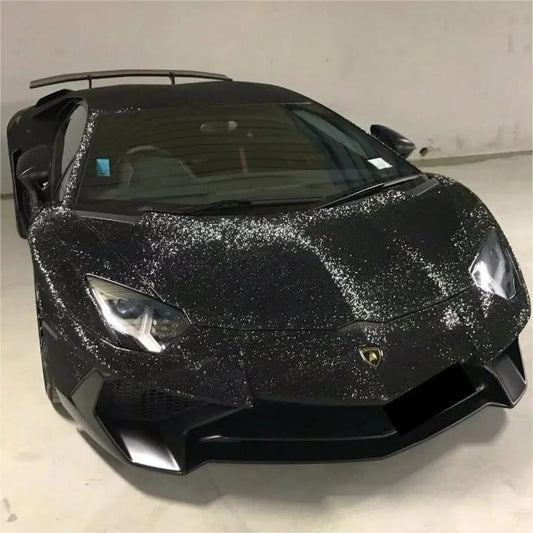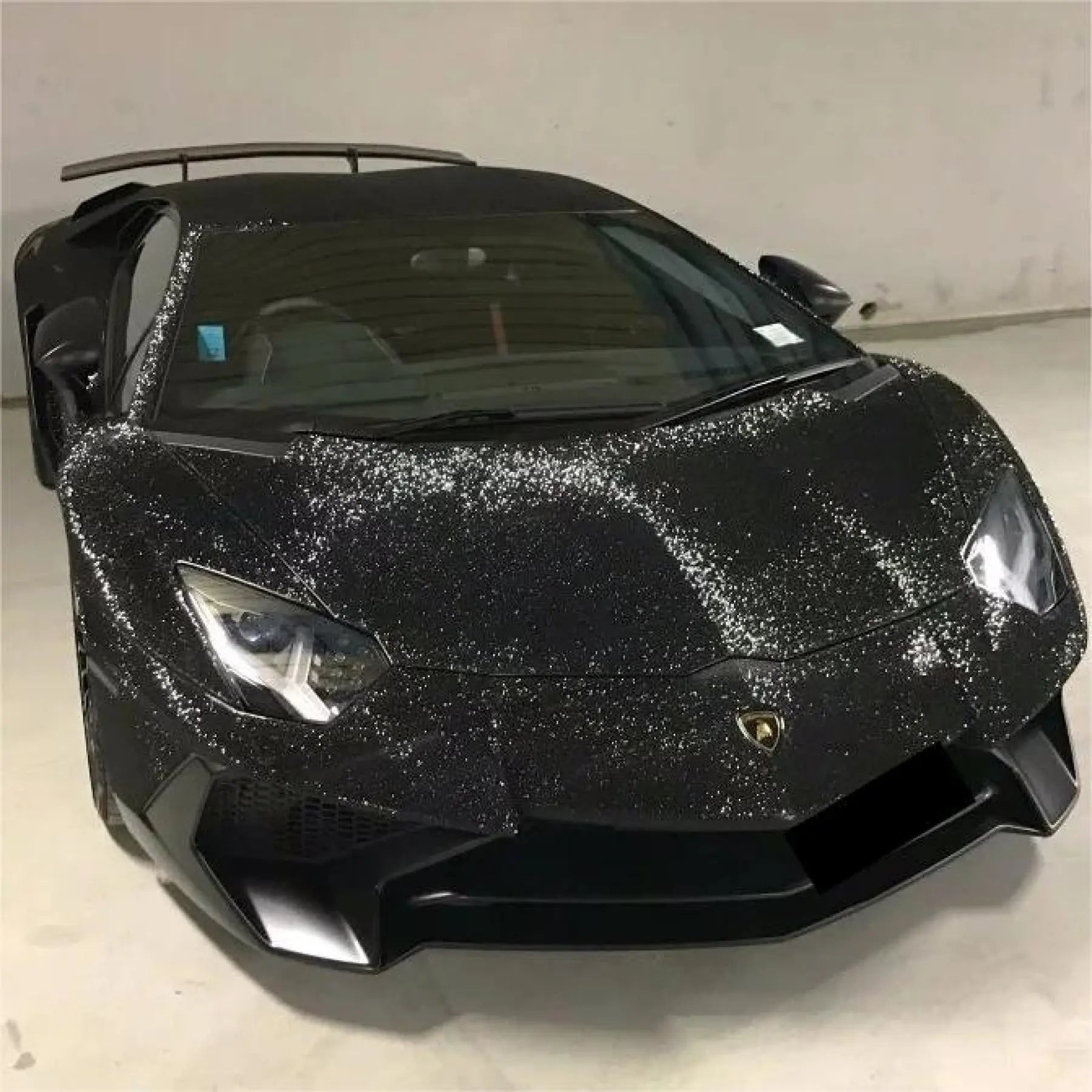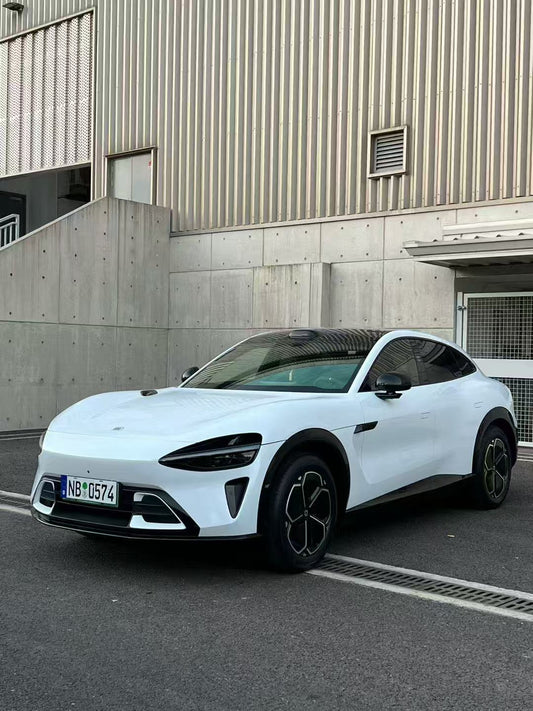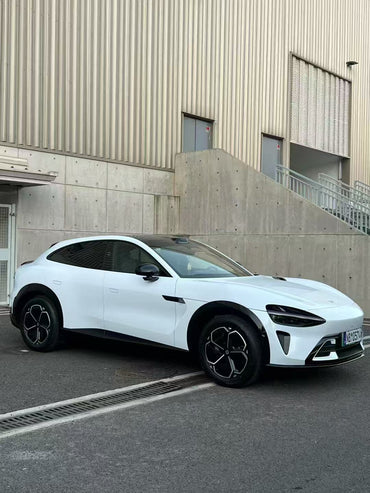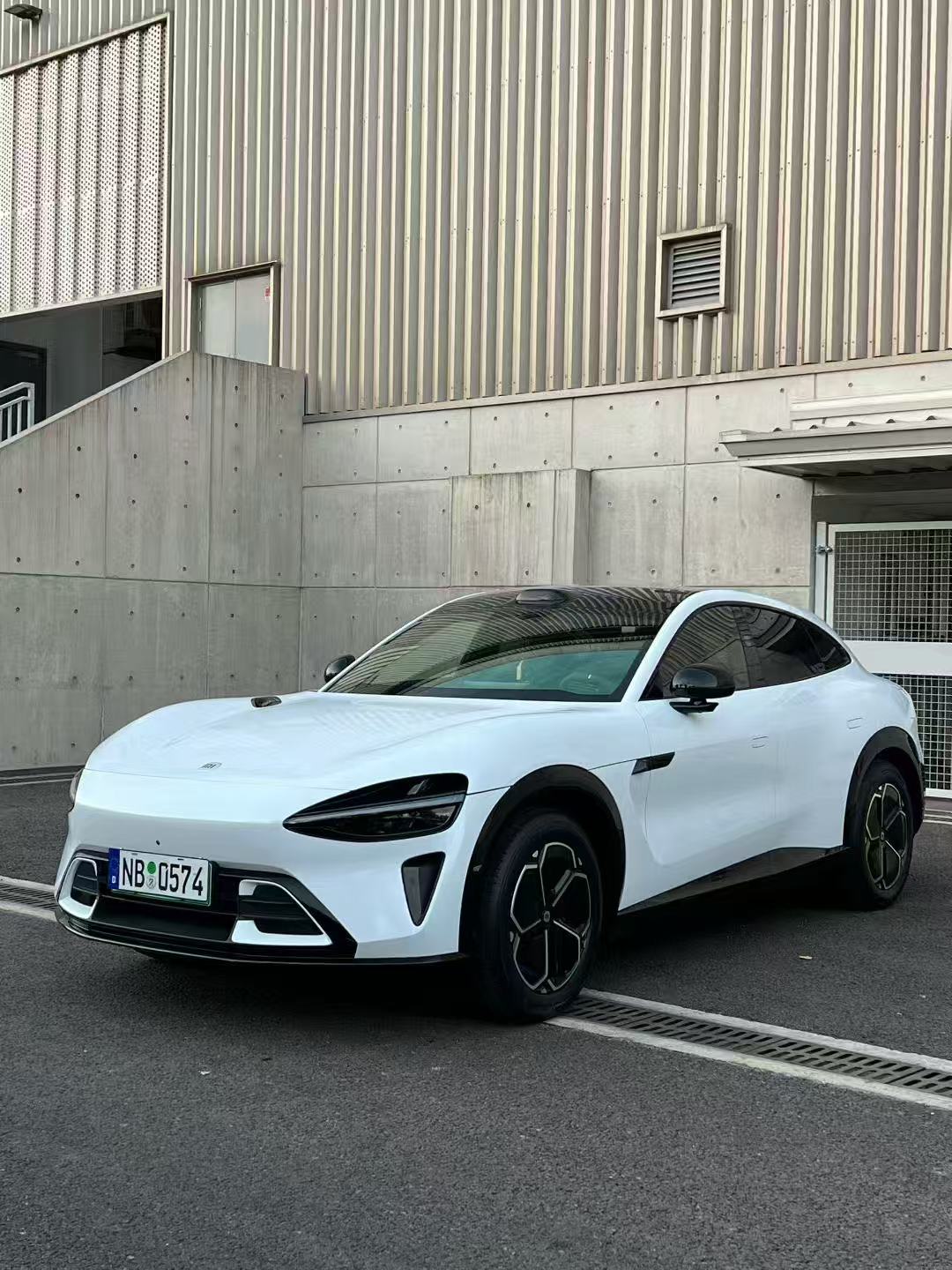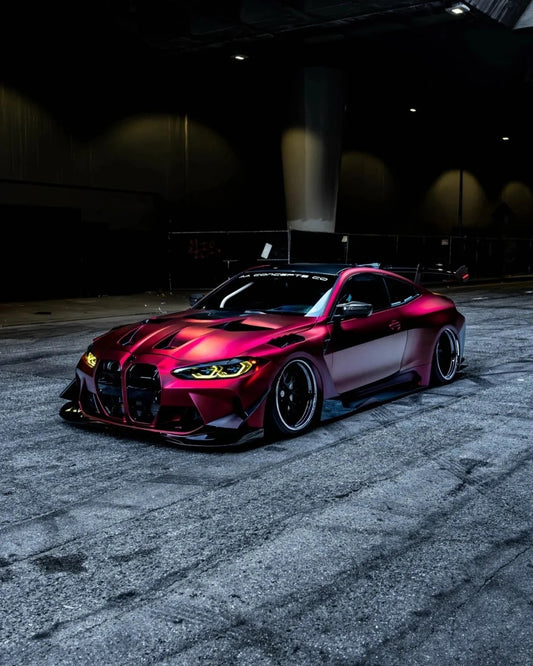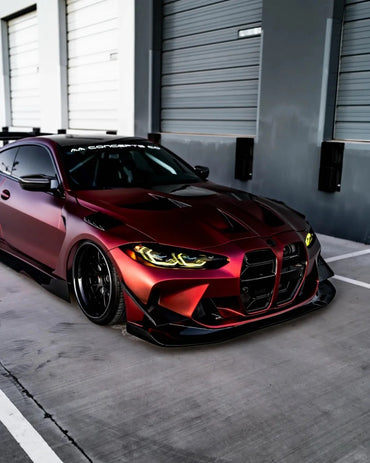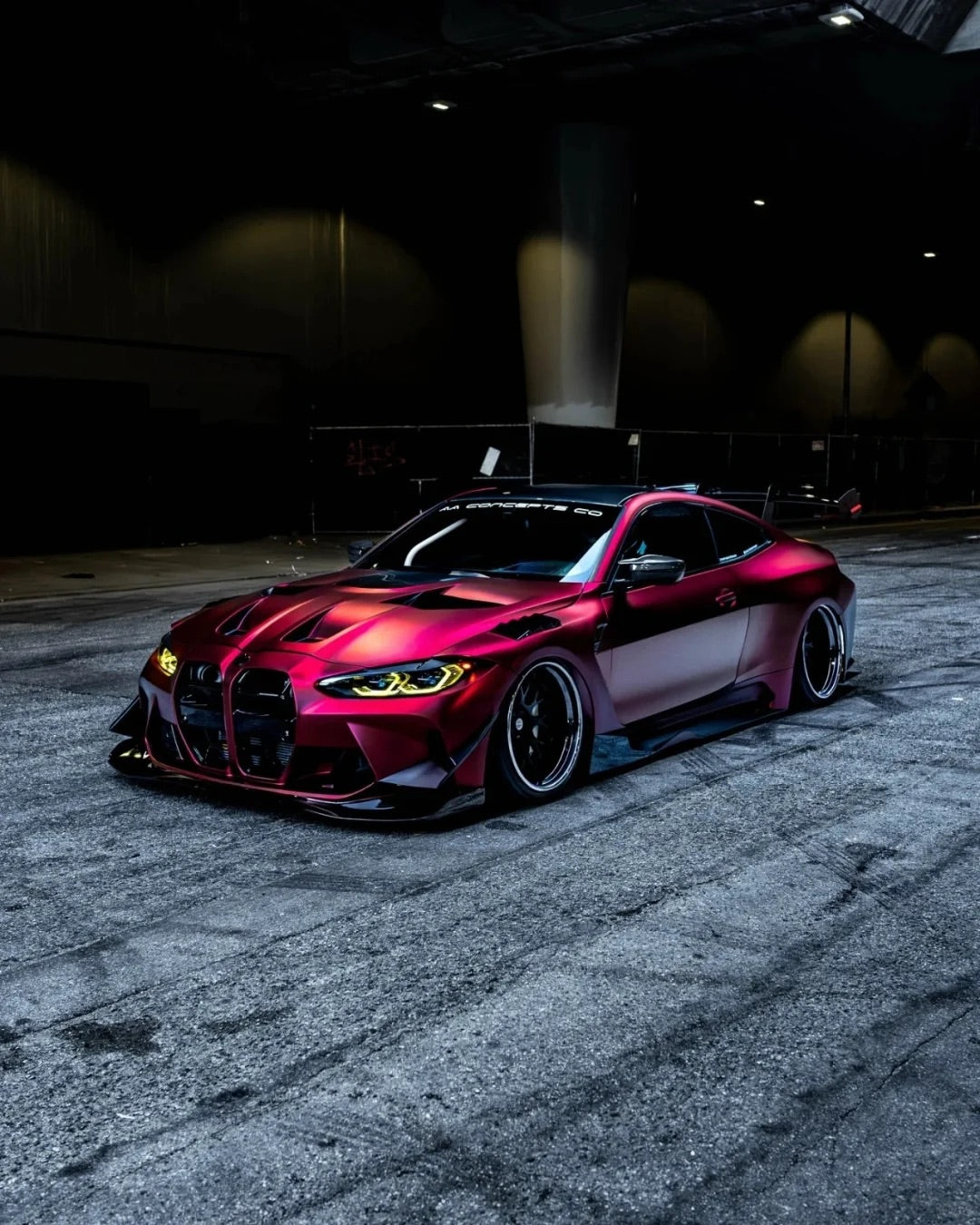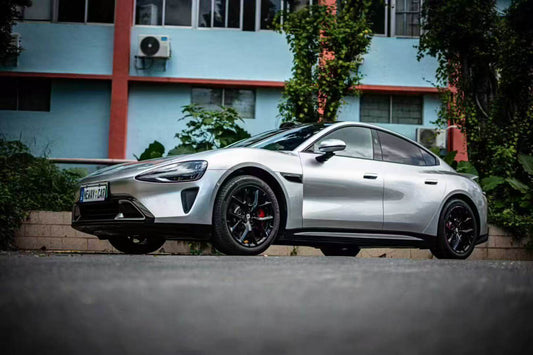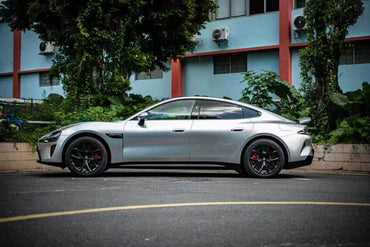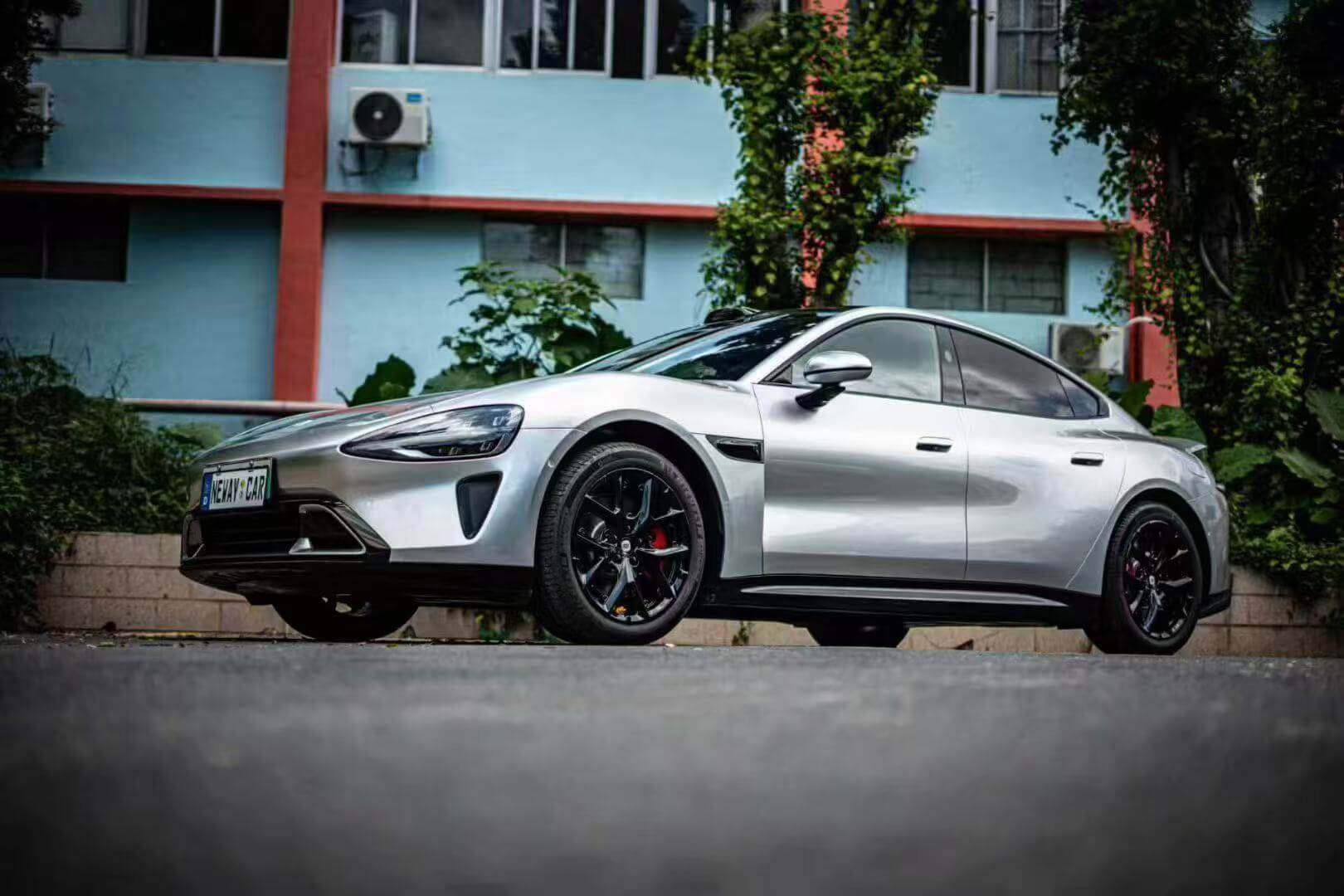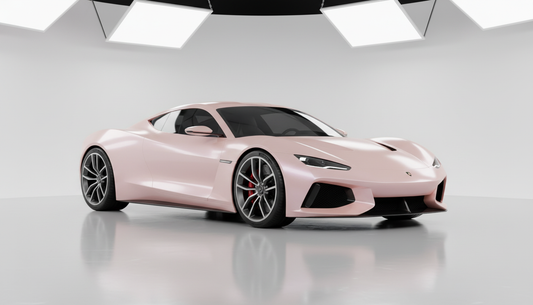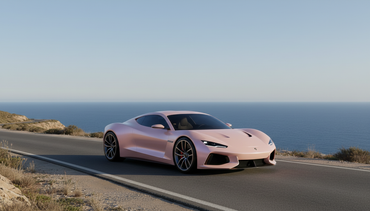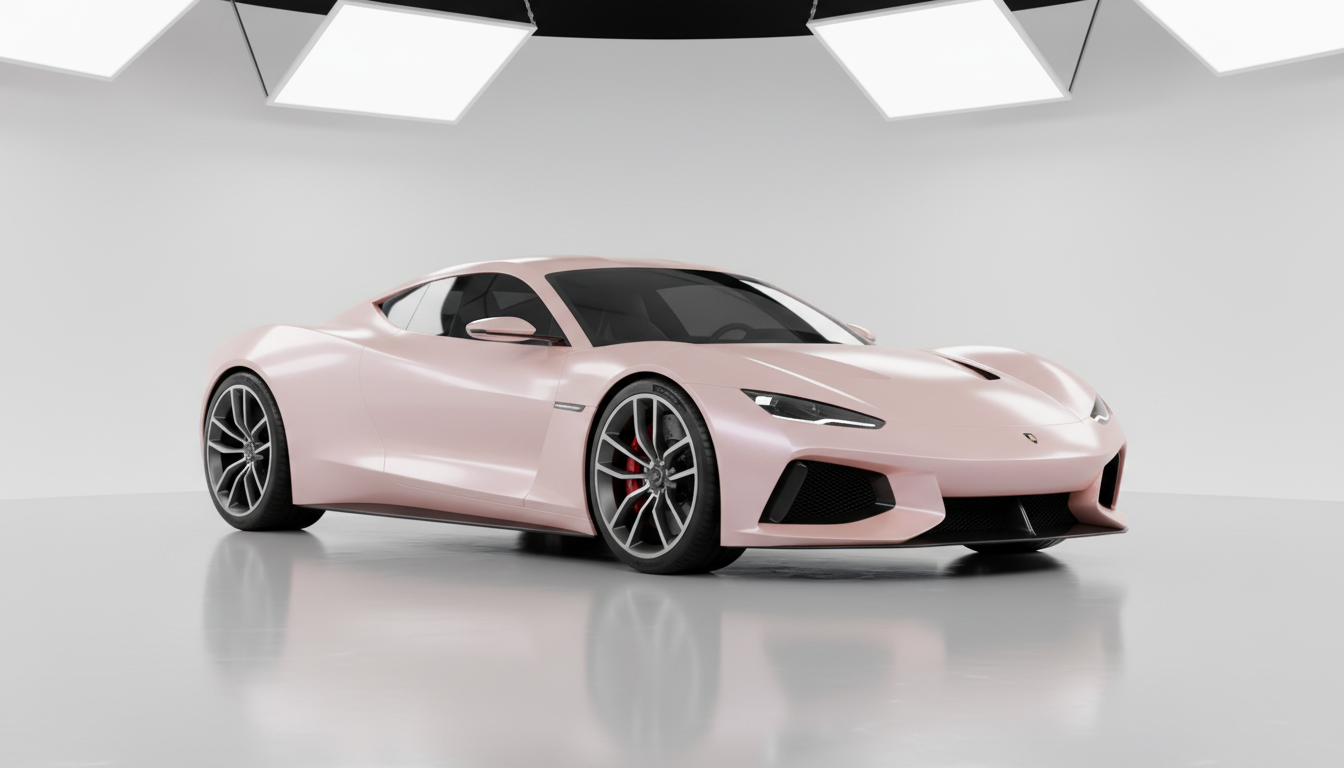Understanding the Basics: What You're Really Getting
Carbon Fiber Wraps: The Smart Alternative
Carbon fiber wraps, also known as 3D carbon fiber wrap, are high-quality vinyl films designed to mimic the distinctive appearance of real carbon fiber. Carbon fiber vinyl is a textured wrap with an adhesive backing that closely imitates the appearance of the real carbon fiber with its intricate weave pattern.
Key Characteristics:
- Premium vinyl construction with printed carbon fiber pattern
- Available in multiple finishes: 3D, 4D, 5D, and 6D variations
- Self-adhesive backing for easy application
- Removable without damaging underlying surfaces
- Protective layer for original paintwork
Real Carbon Fiber: The Authentic Material
Real carbon fiber consists of actual carbon atoms bonded together to form long chains with incredible strength-to-weight ratios. When you purchase genuine carbon fiber materials, you'll find that carbon fabric is inserted into an epoxy resin, creating a composite material with exceptional mechanical properties.
Key Characteristics:
- Actual carbon fiber fabric in epoxy resin matrix
- Superior strength-to-weight ratio
- Genuine structural performance benefits
- Permanent installation typically required
- Premium manufacturing costs
Visual Differences: Can You Tell Them Apart?
The Authenticity Factor
While vinyl wraps do come close to the real deal's aesthetics, some people claim that it doesn't have the depth of carbon fiber. However, modern carbon fiber wraps have achieved remarkable visual fidelity.
Real Carbon Fiber Visual Characteristics:
- Deep, three-dimensional weave pattern visible through clear coat
- Genuine fabric layering creates natural depth variations
- Light reflection shows true fiber orientation
- Authentic texture you can feel through the resin
- Pattern misalignments from fabric joining are embedded deep within
Carbon Fiber Wrap Visual Characteristics:
- 3D carbon fiber vinyl is considered the most fundamental type in the carbon fiber wrap category. It is known for its matte finish and distinct textured surface
- Advanced 4D, 5D, and 6D options offer increasing levels of gloss and realism
- Modern wraps feature embossed textures for tactile authenticity
- High-quality options can fool casual observers
- Surface-level pattern joining in premium wraps
Finish Options Comparison
Our comprehensive car vinyl wrap collection showcases the evolution of carbon fiber aesthetics:
Carbon Fiber Wrap Finishes:
- Matte Finish: Subtle, sophisticated appearance from our Ultra Matte Wrap collection
- Gloss Finish: High-shine appearance similar to clear-coated real carbon fiber
- Metallic Variants: Enhanced depth from our Metallic Vinyl Wrap series
- Textured Options: 3D embossed surfaces for authentic feel
Real Carbon Fiber Finishes:
- Clear coat over raw carbon (most common)
- Matte clear coat for understated luxury
- Color-tinted clear coats (though this affects authenticity)
- Natural weave visibility through resin
Cost Comparison: The Financial Reality
Initial Investment Analysis
The cost difference between carbon fiber wraps and real carbon fiber parts is substantial and often the deciding factor for most consumers.
Carbon Fiber Wrap Costs:
- Material Cost: $50-$150 per linear yard for premium vinyl
- Professional Installation: $500-$2,500 for full vehicle wrap
- DIY Installation: Significant savings with our Sample Kits for practice
- Partial Wrapping: $100-$500 for accent pieces (hood, roof, mirrors)
- Total Investment: $450-$500 to wrap a hood vs. $1,500+ for real carbon fiber hood
Real Carbon Fiber Costs:
- Material Cost: $10-$12 per pound plus manufacturing markup
- Single Hood: $750-$2,000+ depending on vehicle and complexity
- Full Body Kit: $10,000-$25,000+ for complete conversion
- Installation: Often requires professional mounting and modification
- Replacement Parts: Individual components can cost thousands
Long-term Value Considerations
Carbon Fiber Wrap Advantages:
- Reversible modification preserves original vehicle value
- Easy replacement if damaged or style preferences change
- Protective benefits preserve underlying paintwork
- Lower insurance implications
- Resale flexibility - remove before selling
Real Carbon Fiber Advantages:
- Permanent enhancement may increase vehicle value for enthusiasts
- Structural benefits in performance applications
- Authentic material appeals to purists
- Potential weight reduction benefits
- Long-term durability in demanding conditions
Application Uses: Where Each Excels
Carbon Fiber Wrap Applications
Our 3D Carbon Fiber Wrap collection serves diverse applications:
Automotive Applications:
- Interior Trim: Dashboard, center console, door panels
- Exterior Accents: Hood, roof, mirrors, spoilers, trim pieces
- Full Vehicle Wraps: Complete aesthetic transformation
- Commercial Vehicles: Fleet customization and branding
Beyond Automotive:
- Electronics: Laptops, phones, gaming accessories
- Home Decor: Furniture accents, wall panels
- Marine: Boat interiors and exterior accents
- Architectural: Modern design elements
Real Carbon Fiber Applications
High-Performance Automotive:
- Structural components requiring weight reduction
- Hood, trunk, and body panels for race cars
- Roll cages and safety equipment
- Performance-critical suspension components
Industrial and Aerospace:
- Aircraft components requiring strength-to-weight optimization
- Marine applications in harsh environments
- Industrial reinforcement and repair
- Sports equipment requiring genuine performance benefits
Hybrid Applications
For maximum value, many enthusiasts combine both approaches:
- Real carbon fiber for performance-critical components
- Carbon fiber wrap for aesthetic areas and interior trim
- Strategic use based on functional requirements vs. visual impact
Technical Performance Comparison
Durability and Longevity
Carbon Fiber Wrap Performance:
- 5-7 years outdoor durability with premium materials
- UV resistance prevents fading and degradation
- Weather-resistant adhesive systems
- Removable without residue when properly installed
- Scratch and impact protection for underlying surfaces
Real Carbon Fiber Performance:
- All real carbon fiber parts will yellow eventually. Using good materials (epoxy and clearcoat) will slow it down though
- Superior structural integrity and impact resistance
- Permanent installation provides long-term benefits
- May require refinishing due to UV degradation over time
- Exceptional strength-to-weight ratio for performance applications
Carbon Fiber Wrap vs. Real Carbon Fiber: Visual Differences, Cost Comparison & Application Uses | Sailifilm
Meta Description: Discover the key differences between carbon fiber wraps and real carbon fiber. Complete comparison guide covering cost, visuals, and applications for smart buyers.
The Ultimate Carbon Fiber Wrap vs. Real Carbon Fiber Showdown
The debate between carbon fiber wraps and real carbon fiber has intensified in 2025, with both options offering distinct advantages for vehicle customization and industrial applications. When comparing real carbon fiber parts and a carbon fiber wrap, the cost is one of the distinctions, but there's much more to consider than just price.
Whether you're looking to enhance your vehicle's aesthetic appeal or seeking functional performance benefits, understanding the fundamental differences between these two options will help you make an informed decision. Let's dive deep into the visual differences, cost comparisons, and application uses to determine which solution best fits your needs.
Understanding the Basics: What You're Really Getting
Carbon Fiber Wraps: The Smart Alternative
Carbon fiber wraps, also known as 3D carbon fiber wrap, are high-quality vinyl films designed to mimic the distinctive appearance of real carbon fiber. Carbon fiber vinyl is a textured wrap with an adhesive backing that closely imitates the appearance of the real carbon fiber with its intricate weave pattern.
Key Characteristics:
- Premium vinyl construction with printed carbon fiber pattern
- Available in multiple finishes: 3D, 4D, 5D, and 6D variations
- Self-adhesive backing for easy application
- Removable without damaging underlying surfaces
- Protective layer for original paintwork
Real Carbon Fiber: The Authentic Material
Real carbon fiber consists of actual carbon atoms bonded together to form long chains with incredible strength-to-weight ratios. When you purchase genuine carbon fiber materials, you'll find that carbon fabric is inserted into an epoxy resin, creating a composite material with exceptional mechanical properties.
Key Characteristics:
- Actual carbon fiber fabric in epoxy resin matrix
- Superior strength-to-weight ratio
- Genuine structural performance benefits
- Permanent installation typically required
- Premium manufacturing costs
Visual Differences: Can You Tell Them Apart?
The Authenticity Factor
While vinyl wraps do come close to the real deal's aesthetics, some people claim that it doesn't have the depth of carbon fiber. However, modern carbon fiber wraps have achieved remarkable visual fidelity.
Real Carbon Fiber Visual Characteristics:
- Deep, three-dimensional weave pattern visible through clear coat
- Genuine fabric layering creates natural depth variations
- Light reflection shows true fiber orientation
- Authentic texture you can feel through the resin
- Pattern misalignments from fabric joining are embedded deep within
Carbon Fiber Wrap Visual Characteristics:
- 3D carbon fiber vinyl is considered the most fundamental type in the carbon fiber wrap category. It is known for its matte finish and distinct textured surface
- Advanced 4D, 5D, and 6D options offer increasing levels of gloss and realism
- Modern wraps feature embossed textures for tactile authenticity
- High-quality options can fool casual observers
- Surface-level pattern joining in premium wraps
Finish Options Comparison
Our comprehensive car vinyl wrap collection showcases the evolution of carbon fiber aesthetics:
Carbon Fiber Wrap Finishes:
- Matte Finish: Subtle, sophisticated appearance from our Ultra Matte Wrap collection
- Gloss Finish: High-shine appearance similar to clear-coated real carbon fiber
- Metallic Variants: Enhanced depth from our Metallic Vinyl Wrap series
- Textured Options: 3D embossed surfaces for authentic feel
Real Carbon Fiber Finishes:
- Clear coat over raw carbon (most common)
- Matte clear coat for understated luxury
- Color-tinted clear coats (though this affects authenticity)
- Natural weave visibility through resin
Cost Comparison: The Financial Reality
Initial Investment Analysis
The cost difference between carbon fiber wraps and real carbon fiber parts is substantial and often the deciding factor for most consumers.
Carbon Fiber Wrap Costs:
- Material Cost: $50-$150 per linear yard for premium vinyl
- Professional Installation: $500-$2,500 for full vehicle wrap
- DIY Installation: Significant savings with our Sample Kits for practice
- Partial Wrapping: $100-$500 for accent pieces (hood, roof, mirrors)
- Total Investment: $450-$500 to wrap a hood vs. $1,500+ for real carbon fiber hood
Real Carbon Fiber Costs:
- Material Cost: $10-$12 per pound plus manufacturing markup
- Single Hood: $750-$2,000+ depending on vehicle and complexity
- Full Body Kit: $10,000-$25,000+ for complete conversion
- Installation: Often requires professional mounting and modification
- Replacement Parts: Individual components can cost thousands
Long-term Value Considerations
Carbon Fiber Wrap Advantages:
- Reversible modification preserves original vehicle value
- Easy replacement if damaged or style preferences change
- Protective benefits preserve underlying paintwork
- Lower insurance implications
- Resale flexibility - remove before selling
Real Carbon Fiber Advantages:
- Permanent enhancement may increase vehicle value for enthusiasts
- Structural benefits in performance applications
- Authentic material appeals to purists
- Potential weight reduction benefits
- Long-term durability in demanding conditions
Application Uses: Where Each Excels
Carbon Fiber Wrap Applications
Our 3D Carbon Fiber Wrap collection serves diverse applications:
Automotive Applications:
- Interior Trim: Dashboard, center console, door panels
- Exterior Accents: Hood, roof, mirrors, spoilers, trim pieces
- Full Vehicle Wraps: Complete aesthetic transformation
- Commercial Vehicles: Fleet customization and branding
Beyond Automotive:
- Electronics: Laptops, phones, gaming accessories
- Home Decor: Furniture accents, wall panels
- Marine: Boat interiors and exterior accents
- Architectural: Modern design elements
Real Carbon Fiber Applications
High-Performance Automotive:
- Structural components requiring weight reduction
- Hood, trunk, and body panels for race cars
- Roll cages and safety equipment
- Performance-critical suspension components
Industrial and Aerospace:
- Aircraft components requiring strength-to-weight optimization
- Marine applications in harsh environments
- Industrial reinforcement and repair
- Sports equipment requiring genuine performance benefits
Hybrid Applications
For maximum value, many enthusiasts combine both approaches:
- Real carbon fiber for performance-critical components
- Carbon fiber wrap for aesthetic areas and interior trim
- Strategic use based on functional requirements vs. visual impact
Technical Performance Comparison
Durability and Longevity
Carbon Fiber Wrap Performance:
- 5-7 years outdoor durability with premium materials
- UV resistance prevents fading and degradation
- Weather-resistant adhesive systems
- Removable without residue when properly installed
- Scratch and impact protection for underlying surfaces
Real Carbon Fiber Performance:
- All real carbon fiber parts will yellow eventually. Using good materials (epoxy and clearcoat) will slow it down though
- Superior structural integrity and impact resistance
- Permanent installation provides long-term benefits
- May require refinishing due to UV degradation over time
- Exceptional strength-to-weight ratio for performance applications
Installation Requirements
Carbon Fiber Wrap Installation:
- DIY-friendly with proper tools from our Wrapping Tools collection
- Heat gun and squeegee application
- Forgiving material allows repositioning
- No permanent modifications required
- Professional installation recommended for complex curves
Real Carbon Fiber Installation:
- Requires professional fabrication and installation
- May need mounting point modifications
- Permanent adhesive or mechanical fastening
- Precise fit and finish requirements
- Potential need for additional hardware
Maintenance and Care Requirements
Carbon Fiber Wrap Maintenance
Maintaining your carbon fiber wrap investment is straightforward:
Regular Care:
- Gentle washing with mild detergents
- Avoid abrasive materials and harsh chemicals
- UV protection helps maintain color and adhesion
- Professional detailing products designed for wraps
- Address damage promptly to prevent edge lifting
Protection Strategies:
- Combine with our TPU Paint Protection Wrap for ultimate protection
- Use Colored Paint Protection Film for high-impact areas
- Regular inspection for edge lifting or damage
Real Carbon Fiber Maintenance
Ongoing Requirements:
- Regular clear coat maintenance and polishing
- UV protection to prevent yellowing
- Professional repair for chips or cracks
- Potential refinishing every 5-10 years depending on exposure
- Structural inspection for load-bearing components
Style and Customization Options
Carbon Fiber Wrap Versatility
Our extensive color collections complement carbon fiber aesthetics:
Color Coordination Options:
- Classic Black Wraps for timeless appeal
- Sophisticated Grey Wraps for modern luxury
- Bold Red Wraps for sports car aesthetics
- Unique Dual-Color Dream Vinyl Wrap combinations
Advanced Finish Options:
- Rainbow Laser Vinyl Wrap for futuristic appeal
- Liquid Chrome Wrap for ultimate luxury
- Crystal Vinyl Wrap for unique translucent effects
Real Carbon Fiber Limitations
Real carbon fiber offers limited customization:
- Natural black/grey carbon weave pattern
- Clear coat variations (gloss, matte, tinted)
- Weave pattern variations (twill, plain, custom)
- Limited color options without compromising authenticity
Environmental and Sustainability Considerations
Carbon Fiber Wrap Environmental Impact
Positive Aspects:
- Preserves original components, reducing waste
- Removable and potentially recyclable materials
- No permanent modifications required
- Extends life of underlying surfaces
Considerations:
- Vinyl production environmental impact
- End-of-life disposal considerations
- Transportation and packaging footprint
Real Carbon Fiber Environmental Impact
Production Considerations:
- Energy-intensive manufacturing process
- Specialized facilities and equipment required
- Limited recycling options at end of life
- Raw material sourcing and processing impact
Performance Benefits:
- Weight reduction improves fuel efficiency
- Durability reduces replacement frequency
- Potential for structural efficiency gains
Professional Recommendations
Choose Carbon Fiber Wrap When:
- Budget is a primary concern - Achieve 90% of the visual impact for 20% of the cost
- Flexibility is important - Want to change styles or preserve resale value
- DIY installation appeals to you - Enjoy customization projects
- Protecting original surfaces - Maintain factory finish underneath
- Exploring different aesthetics - Test carbon fiber look before permanent commitment
Best Applications:
- Interior trim and dashboard accents
- Exterior cosmetic elements (mirrors, trim)
- Full vehicle aesthetic transformation
- Commercial fleet customization
- Temporary or seasonal modifications
Choose Real Carbon Fiber When:
- Performance benefits are required - Weight reduction is functionally important
- Authenticity matters - Purist approach to modifications
- Structural applications - Load-bearing or safety-critical components
- Long-term permanent solution desired - One-time investment approach
- Budget allows for premium materials - Cost is not the primary concern
Best Applications:
- Hood and trunk lids for weight reduction
- Performance-oriented body panels
- Structural reinforcement projects
- Race car components
- High-end show car builds
Market Trends and Future Outlook
2025 Industry Developments
The Global Carbon Fiber Wraps (Construction) Market was valued at USD 2.7 billion in 2024 and is estimated to grow at a CAGR of 11.3% to reach USD 7.7 billion by 2034, indicating strong growth in wrap applications across industries.
Carbon Fiber Wrap vs. Real Carbon Fiber: Visual Differences, Cost Comparison & Application Uses | Sailifilm
Meta Description: Discover the key differences between carbon fiber wraps and real carbon fiber. Complete comparison guide covering cost, visuals, and applications for smart buyers.
The Ultimate Carbon Fiber Wrap vs. Real Carbon Fiber Showdown
The debate between carbon fiber wraps and real carbon fiber has intensified in 2025, with both options offering distinct advantages for vehicle customization and industrial applications. When comparing real carbon fiber parts and a carbon fiber wrap, the cost is one of the distinctions, but there's much more to consider than just price.
Whether you're looking to enhance your vehicle's aesthetic appeal or seeking functional performance benefits, understanding the fundamental differences between these two options will help you make an informed decision. Let's dive deep into the visual differences, cost comparisons, and application uses to determine which solution best fits your needs.
Understanding the Basics: What You're Really Getting
Carbon Fiber Wraps: The Smart Alternative
Carbon fiber wraps, also known as 3D carbon fiber wrap, are high-quality vinyl films designed to mimic the distinctive appearance of real carbon fiber. Carbon fiber vinyl is a textured wrap with an adhesive backing that closely imitates the appearance of the real carbon fiber with its intricate weave pattern.
Key Characteristics:
- Premium vinyl construction with printed carbon fiber pattern
- Available in multiple finishes: 3D, 4D, 5D, and 6D variations
- Self-adhesive backing for easy application
- Removable without damaging underlying surfaces
- Protective layer for original paintwork
Real Carbon Fiber: The Authentic Material
Real carbon fiber consists of actual carbon atoms bonded together to form long chains with incredible strength-to-weight ratios. When you purchase genuine carbon fiber materials, you'll find that carbon fabric is inserted into an epoxy resin, creating a composite material with exceptional mechanical properties.
Key Characteristics:
- Actual carbon fiber fabric in epoxy resin matrix
- Superior strength-to-weight ratio
- Genuine structural performance benefits
- Permanent installation typically required
- Premium manufacturing costs
Visual Differences: Can You Tell Them Apart?
The Authenticity Factor
While vinyl wraps do come close to the real deal's aesthetics, some people claim that it doesn't have the depth of carbon fiber. However, modern carbon fiber wraps have achieved remarkable visual fidelity.
Real Carbon Fiber Visual Characteristics:
- Deep, three-dimensional weave pattern visible through clear coat
- Genuine fabric layering creates natural depth variations
- Light reflection shows true fiber orientation
- Authentic texture you can feel through the resin
- Pattern misalignments from fabric joining are embedded deep within
Carbon Fiber Wrap Visual Characteristics:
- 3D carbon fiber vinyl is considered the most fundamental type in the carbon fiber wrap category. It is known for its matte finish and distinct textured surface
- Advanced 4D, 5D, and 6D options offer increasing levels of gloss and realism
- Modern wraps feature embossed textures for tactile authenticity
- High-quality options can fool casual observers
- Surface-level pattern joining in premium wraps
Finish Options Comparison
Our comprehensive car vinyl wrap collection showcases the evolution of carbon fiber aesthetics:
Carbon Fiber Wrap Finishes:
- Matte Finish: Subtle, sophisticated appearance from our Ultra Matte Wrap collection
- Gloss Finish: High-shine appearance similar to clear-coated real carbon fiber
- Metallic Variants: Enhanced depth from our Metallic Vinyl Wrap series
- Textured Options: 3D embossed surfaces for authentic feel
Real Carbon Fiber Finishes:
- Clear coat over raw carbon (most common)
- Matte clear coat for understated luxury
- Color-tinted clear coats (though this affects authenticity)
- Natural weave visibility through resin
Cost Comparison: The Financial Reality
Initial Investment Analysis
The cost difference between carbon fiber wraps and real carbon fiber parts is substantial and often the deciding factor for most consumers.
Carbon Fiber Wrap Costs:
- Material Cost: $50-$150 per linear yard for premium vinyl
- Professional Installation: $500-$2,500 for full vehicle wrap
- DIY Installation: Significant savings with our Sample Kits for practice
- Partial Wrapping: $100-$500 for accent pieces (hood, roof, mirrors)
- Total Investment: $450-$500 to wrap a hood vs. $1,500+ for real carbon fiber hood
Real Carbon Fiber Costs:
- Material Cost: $10-$12 per pound plus manufacturing markup
- Single Hood: $750-$2,000+ depending on vehicle and complexity
- Full Body Kit: $10,000-$25,000+ for complete conversion
- Installation: Often requires professional mounting and modification
- Replacement Parts: Individual components can cost thousands
Long-term Value Considerations
Carbon Fiber Wrap Advantages:
- Reversible modification preserves original vehicle value
- Easy replacement if damaged or style preferences change
- Protective benefits preserve underlying paintwork
- Lower insurance implications
- Resale flexibility - remove before selling
Real Carbon Fiber Advantages:
- Permanent enhancement may increase vehicle value for enthusiasts
- Structural benefits in performance applications
- Authentic material appeals to purists
- Potential weight reduction benefits
- Long-term durability in demanding conditions
Application Uses: Where Each Excels
Carbon Fiber Wrap Applications
Our 3D Carbon Fiber Wrap collection serves diverse applications:
Automotive Applications:
- Interior Trim: Dashboard, center console, door panels
- Exterior Accents: Hood, roof, mirrors, spoilers, trim pieces
- Full Vehicle Wraps: Complete aesthetic transformation
- Commercial Vehicles: Fleet customization and branding
Beyond Automotive:
- Electronics: Laptops, phones, gaming accessories
- Home Decor: Furniture accents, wall panels
- Marine: Boat interiors and exterior accents
- Architectural: Modern design elements
Real Carbon Fiber Applications
High-Performance Automotive:
- Structural components requiring weight reduction
- Hood, trunk, and body panels for race cars
- Roll cages and safety equipment
- Performance-critical suspension components
Industrial and Aerospace:
- Aircraft components requiring strength-to-weight optimization
- Marine applications in harsh environments
- Industrial reinforcement and repair
- Sports equipment requiring genuine performance benefits
Hybrid Applications
For maximum value, many enthusiasts combine both approaches:
- Real carbon fiber for performance-critical components
- Carbon fiber wrap for aesthetic areas and interior trim
- Strategic use based on functional requirements vs. visual impact
Technical Performance Comparison
Durability and Longevity
Carbon Fiber Wrap Performance:
- 5-7 years outdoor durability with premium materials
- UV resistance prevents fading and degradation
- Weather-resistant adhesive systems
- Removable without residue when properly installed
- Scratch and impact protection for underlying surfaces
Real Carbon Fiber Performance:
- All real carbon fiber parts will yellow eventually. Using good materials (epoxy and clearcoat) will slow it down though
- Superior structural integrity and impact resistance
- Permanent installation provides long-term benefits
- May require refinishing due to UV degradation over time
- Exceptional strength-to-weight ratio for performance applications
Installation Requirements
Carbon Fiber Wrap Installation:
- DIY-friendly with proper tools from our Wrapping Tools collection
- Heat gun and squeegee application
- Forgiving material allows repositioning
- No permanent modifications required
- Professional installation recommended for complex curves
Real Carbon Fiber Installation:
- Requires professional fabrication and installation
- May need mounting point modifications
- Permanent adhesive or mechanical fastening
- Precise fit and finish requirements
- Potential need for additional hardware
Maintenance and Care Requirements
Carbon Fiber Wrap Maintenance
Maintaining your carbon fiber wrap investment is straightforward:
Regular Care:
- Gentle washing with mild detergents
- Avoid abrasive materials and harsh chemicals
- UV protection helps maintain color and adhesion
- Professional detailing products designed for wraps
- Address damage promptly to prevent edge lifting
Protection Strategies:
- Combine with our TPU Paint Protection Wrap for ultimate protection
- Use Colored Paint Protection Film for high-impact areas
- Regular inspection for edge lifting or damage
Real Carbon Fiber Maintenance
Ongoing Requirements:
- Regular clear coat maintenance and polishing
- UV protection to prevent yellowing
- Professional repair for chips or cracks
- Potential refinishing every 5-10 years depending on exposure
- Structural inspection for load-bearing components
Style and Customization Options
Carbon Fiber Wrap Versatility
Our extensive color collections complement carbon fiber aesthetics:
Color Coordination Options:
- Classic Black Wraps for timeless appeal
- Sophisticated Grey Wraps for modern luxury
- Bold Red Wraps for sports car aesthetics
- Unique Dual-Color Dream Vinyl Wrap combinations
Advanced Finish Options:
- Rainbow Laser Vinyl Wrap for futuristic appeal
- Liquid Chrome Wrap for ultimate luxury
- Crystal Vinyl Wrap for unique translucent effects
Real Carbon Fiber Limitations
Real carbon fiber offers limited customization:
- Natural black/grey carbon weave pattern
- Clear coat variations (gloss, matte, tinted)
- Weave pattern variations (twill, plain, custom)
- Limited color options without compromising authenticity
Environmental and Sustainability Considerations
Carbon Fiber Wrap Environmental Impact
Positive Aspects:
- Preserves original components, reducing waste
- Removable and potentially recyclable materials
- No permanent modifications required
- Extends life of underlying surfaces
Considerations:
- Vinyl production environmental impact
- End-of-life disposal considerations
- Transportation and packaging footprint
Real Carbon Fiber Environmental Impact
Production Considerations:
- Energy-intensive manufacturing process
- Specialized facilities and equipment required
- Limited recycling options at end of life
- Raw material sourcing and processing impact
Performance Benefits:
- Weight reduction improves fuel efficiency
- Durability reduces replacement frequency
- Potential for structural efficiency gains
Professional Recommendations
Choose Carbon Fiber Wrap When:
- Budget is a primary concern - Achieve 90% of the visual impact for 20% of the cost
- Flexibility is important - Want to change styles or preserve resale value
- DIY installation appeals to you - Enjoy customization projects
- Protecting original surfaces - Maintain factory finish underneath
- Exploring different aesthetics - Test carbon fiber look before permanent commitment
Best Applications:
- Interior trim and dashboard accents
- Exterior cosmetic elements (mirrors, trim)
- Full vehicle aesthetic transformation
- Commercial fleet customization
- Temporary or seasonal modifications
Choose Real Carbon Fiber When:
- Performance benefits are required - Weight reduction is functionally important
- Authenticity matters - Purist approach to modifications
- Structural applications - Load-bearing or safety-critical components
- Long-term permanent solution desired - One-time investment approach
- Budget allows for premium materials - Cost is not the primary concern
Best Applications:
- Hood and trunk lids for weight reduction
- Performance-oriented body panels
- Structural reinforcement projects
- Race car components
- High-end show car builds
Market Trends and Future Outlook
2025 Industry Developments
The Global Carbon Fiber Wraps (Construction) Market was valued at USD 2.7 billion in 2024 and is estimated to grow at a CAGR of 11.3% to reach USD 7.7 billion by 2034, indicating strong growth in wrap applications across industries.
Emerging Trends:
- Advanced vinyl technologies improving realism
- Smart wraps with color-changing capabilities
- Improved adhesive systems for easier installation
- Enhanced UV resistance and longevity
- Integration with paint protection technologies
Technology Advancements
Carbon Fiber Wrap Innovations:
- 6D and beyond wrap technologies
- Self-healing protective coatings
- Enhanced conformability for complex curves
- Improved air-release adhesive systems
- Sustainable vinyl production methods
Real Carbon Fiber Developments:
- Automated manufacturing reducing costs
- Recycled carbon fiber applications
- Bio-based resin systems
- Improved surface treatments
- Advanced weave patterns and architectures
Making the Right Choice for Your Project
Decision Framework
Evaluate Your Priorities:
- Primary Goal: Aesthetic enhancement vs. performance improvement
- Budget Constraints: Initial investment vs. long-term value
- Permanence: Temporary/changeable vs. permanent modification
- Installation Capability: DIY-friendly vs. professional requirement
- Maintenance Commitment: Low-maintenance vs. specialized care
Hybrid Approach Strategy
Many savvy consumers opt for a combined approach:
Phase 1: Start with carbon fiber wrap to test aesthetics
- Use our Sample Kits to evaluate options
- Apply to less critical areas first
- Assess visual impact and satisfaction
Phase 2: Upgrade to real carbon fiber selectively
- Identify performance-critical components
- Maintain wraps for purely aesthetic areas
- Balance cost with functional benefits
Installation and Professional Services
DIY Installation Success Tips
For carbon fiber wrap installation:
Essential Tools from our Wrapping Tools collection:
- Professional heat gun for conformability
- Premium squeegees for bubble-free application
- Sharp cutting tools for precise trimming
- Cleaning supplies for surface preparation
Best Practices:
- Start with simple, flat surfaces
- Work in temperatures between 68-75°F
- Take time with surface preparation
- Use proper heating techniques for curves
- Allow adequate cure time before exposure
Professional Installation Benefits
When to Choose Professional Installation:
- Complex curved surfaces and tight spaces
- Full vehicle wraps requiring seamless appearance
- High-value vehicles requiring perfect finish
- Time constraints or lack of proper workspace
- Warranty considerations and insurance coverage
Conclusion: The Smart Choice for 2025
The carbon fiber wrap vs. real carbon fiber decision ultimately depends on your specific goals, budget, and application requirements. For the majority of automotive enthusiasts and commercial applications, high-quality carbon fiber wraps from our comprehensive collection offer the perfect balance of aesthetics, functionality, and value.
Carbon fiber wraps win when:
- Visual impact is the primary goal
- Budget considerations are important
- Flexibility and reversibility are valued
- DIY installation is preferred
- Multiple vehicle applications are planned
Real carbon fiber wins when:
- Genuine performance benefits are required
- Structural applications demand authentic materials
- Long-term permanent solutions are desired
- Budget allows for premium materials
- Authenticity is non-negotiable
Ready to Transform Your Vehicle?
Explore our complete range of premium car vinyl wraps and discover why thousands of customers choose Sailifilm for their vehicle transformation projects. From our industry-leading 3D Carbon Fiber Wrap to our innovative Best Sellers collection, we have the perfect solution for your vision.
Start your journey with our Sample Kits to experience the quality difference, and don't forget to check out our professional Wrapping Tools for the best installation results.
External References and Further Reading:
- Wikipedia: Carbon Fiber - Comprehensive technical information about carbon fiber materials
- Automotive News: Latest Wrap Technology - Industry developments and market trends
- Materials Science Research - Academic insights into carbon fiber technology


